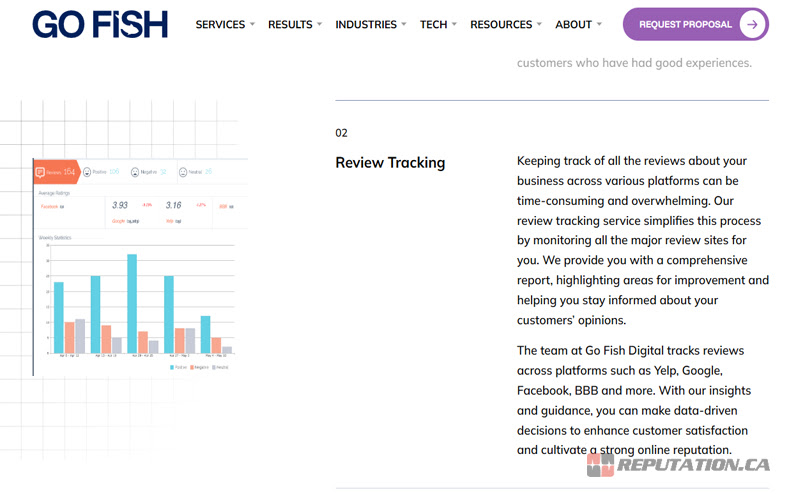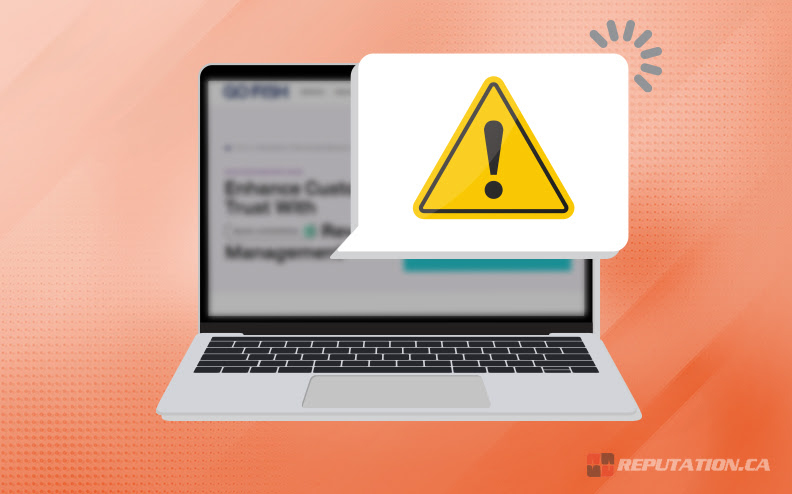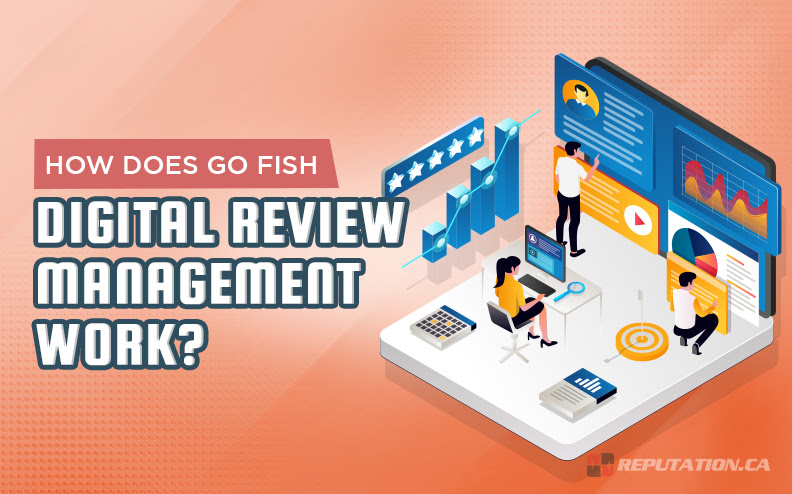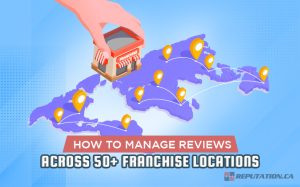Review management across Google, Yelp, Facebook and the other industry-specific sites eats up hours each week that business owners just don’t have to spare. You have to check each platform regularly and write thoughtful replies to the five-star raves and to the one-star complaints, and then somehow find time to convince your happy customers to actually leave reviews. The workload piles up fast.
The consequences are expensive. Studies are showing that when a business drops from four stars to three stars, it loses 70% of consumer trust. Nearly all consumers (93% to be exact) check reviews before they buy anything, and each negative review that goes unaddressed or each opportunity to respond that gets missed will cost you money.
Go Fish Digital has a review management service that claims to solve these problems. I’ll review their platform features, tracking capabilities, response methods and review generation tactics to see if their service actually fits with what your business needs.
Here’s how Go Fish Digital’s review management actually works!
The Parts of the Review Management System
Review management platforms have built their systems a bit differently than what you’ll find with most other providers in this space. Instead of providing a few separate tools that can’t communicate with one another, they’ve integrated everything into one unified system. All your review tracking capabilities, response management features and review generation tools live together in the same platform, and it makes a lot more sense than the alternative.
The platform pulls in reviews from all the big sites that most businesses need to worry about. Google, Yelp and Facebook are all there of course, and it also tracks industry-related sites based on the type of business you run. You won’t have to jump between a dozen different websites every day just to see what customers are posting about you. You can concentrate on the real work instead of endless busywork since everything lands in one main dashboard.

Their single dashboard turns into your reputation management headquarters. All your reviews from different sites appear in one centralized location, and you can respond to them without having to open new tabs or log into multiple accounts. You also get to track how your reputation evolves over time with real data instead of your gut feelings. It makes taking care of your web reputation much easier. It makes sense to manage everything from one comprehensive platform rather than juggling five different sites to manage your reputation.
These platforms monitor somewhere between 50 and 100 different review sites, and it’s pretty standard for the industry. The exact number changes based on your particular industry and geographic location. Some businesses need coverage on the niche directories, and others can concentrate their work on the mainstream sites that drive most of their traffic.
Get Alerts from Every Review Site
Go Fish Digital’s review tracker is an automated tool that watches what customers are saying about your business 24/7. The platform scans through dozens of review sites every few hours and catches any new mentions of your company. Whenever a customer leaves a review about your business on any platform across the web, the system flags it immediately for you to see.
New reviews won’t sit unnoticed for days or weeks anymore. The platform sends out alerts via email or text message, and you get to choose which way works best for your schedule. There’s also a main dashboard where all your notifications live in one convenient place. It’s a massive improvement over the old days of manually logging into each review site one by one to check for new feedback.
Customization is where the platform works the best, though. Different types of reviews can trigger different alert settings based on what you need. For example, a 1-star review might warrant an immediate text alert to your phone, and 5-star reviews could just roll into a daily email digest. Your team gets to set what’s most important for your goals.

What I find especially helpful is the platform’s ability to monitor all the smaller, industry-niche review sites that most businesses miss. While everyone keeps an eye on Google and Yelp, you’ll find that there are dozens of niche sites where customers leave feedback that could sit unnoticed for months. Go Fish Digital tracks every one of them, including the ones you’ve probably never heard of.
The system’s algorithms are always scanning for possible fake review activity. Suspicious patterns get flagged automatically – instances like when multiple reviews come from the same IP address or a few reviews that use nearly identical wording. When competitors try to manipulate your ratings with fake negative reviews, the system helps you catch it before any real damage is done.
Most business owners who switch to automated review tracking usually save somewhere between 3 to 4 hours a week. With the large number of review sites that are out there now, those hours start to add up over the course of a month or a year. You can spend that time on activities that actually grow your business since the automated system takes care of all the repetitive checking and tracking.
How They Handle Your Review Responses
Go Fish Digital takes review replies to heart, and for a very important reason – first impressions online can make or break a business. When a customer posts a review about your company, their team gets to work fast, usually within 24 to 48 hours at most. Google actually tracks response times and rewards businesses that stay on top of their reviews, and it helps improve your position in search rankings.
Their way of managing the response writing is actually pretty smart once you look at it closely. Every response they write is different and is written specifically to match what the customer said in their review. They also remember your brand’s voice, and they adjust accordingly. A law firm gets professional replies that sound like a law firm should sound. A surf shop gets replies that feel relaxed and beachy. It just makes sense to line up with the tone your customers already expect from you.

Negative reviews deserve extra care, and I’d argue that’s where Go Fish Digital does its best work. Instead of brushing off complaints or becoming defensive about criticism, they use these reviews as opportunities to show how much your business values customer feedback. The data supports it too – businesses that actively respond to reviews usually see conversion rates jump by around 15% compared to those businesses that never respond at all.
They’ve managed to find a sweet balance between speed and authenticity that fits businesses that don’t have time to manage reviews themselves. While they have templates to help them work faster, every response still includes personal touches based on what the reviewer specifically mentioned in their feedback. Generic robotic replies make customers lose interest right away. But to write custom replies for hundreds of reviews would be impossible to maintain. Go Fish Digital has developed a system that delivers personalized replies at scale, and most customers never know that a third party helped write the message.
Build Your Customer Review Campaign
The best time for review requests is somewhere between 7 and 14 days after customers buy something or after a service appointment. Any sooner than that, and customers haven’t had enough time to develop a strong opinion about their experience. Wait much longer than 2 weeks, though, and they’ve already forgotten most of the little details or just don’t care enough anymore to write about it. The timing has to be just right for this to work well.
Go Fish Digital has a few options that they can use to help businesses connect with their customers, and email campaigns are usually the main part of what they do. Text messages are another great option for some businesses – they work especially well for service businesses where customers already give out their phone numbers when they book appointments. Physical stores have even more possibilities at their disposal. They can put QR codes in the right spots around the store, or they might set up tablets near the exit so customers can leave feedback on their way out. Every business is a little bit different, and the best combination of tools depends on who your customers are and how they like to communicate with your brand.

Platform guidelines make this whole process a bit more complicated than it needs to be. Google, Yelp, and other review sites have extremely strict policies on what you can and can’t do when asking for reviews. Incentives are off the table (no discounts, no freebies) and not even a slight suggestion that customers might get something in return. Violate these guidelines and the platform might delete all the reviews your business has earned, or worse, ban your listing completely. I’ve seen it with businesses that thought they’d bend the policies just a little.
The most successful way forward balances persistence with respect for the customer’s time and choice. A well-designed system makes it easy for satisfied customers to share their experiences without any pressure or awkward requests. Businesses with these organized systems routinely get 3 to 10 times more reviews than competitors who count on chance alone.
How the Complete Service Actually Works
Go Fish has organized their review management services into a few different pricing tiers, and each one tries to match what different types of businesses are actually going to need.
At the lower end of the scale, their basic packages have fairly basic tracking features, and as you move up the pricing ladder, the premium options bring in full response management capabilities along with very detailed analytics and reporting. Most businesses land somewhere between $500 and $3,000 per month, and the exact price depends on a few main factors, like how many locations you need coverage for and which service level actually makes sense for your goals.

When you start everything up with their system, it’s going to take some time – usually somewhere in the neighborhood of two to four weeks from start to finish. The process kicks off with an audit of your existing review situation and gives them (and you) a transparent picture of where your business stands right now. After that first assessment, they move into the configuration phase, where they get all the services connected and set up, and then they wrap up with complete training for your team on the ins and outs of the system. It does take some patience on your part, but most businesses that go through the process say that the results are worth the wait.
Contract flexibility is something that you want to bring up early in the conversation. Some of their packages are going to lock you in for a full year, and others give you the freedom of monthly billing. Monthly arrangements do have a higher price tag, but they give you the chance to test out the service and see if it delivers the results you’re after before you make a longer commitment.
The return on investment calculations for review management can be pretty strong when you sit down and run the numbers. Harvard studies found that just a single star increase in your average rating can translate to a 5% to 9% bump in revenue. For a business that’s bringing in $50,000 a month, we’re talking about an extra $2,500 to $4,500 in revenue each month just from that one-star improvement.
At the end of the day, the question you need to ask yourself has less to do with whether review management will pay for itself and more to do with whether you can afford to sit on the sidelines as your competitors are actively working on their online reputation. Most businesses discover that even a basic review management package gives them the tools they need to keep their competitive edge in the local market.
Monitor and Manage Your Reputation
The three main parts we covered each do their own job – the tracking side tracks what your customers are saying across every platform out there, the response tools let you get back to them fast and still sound professional, and the outreach features actually get happy customers to leave you positive reviews without any hassle. Put them all together, and they really do change how your business looks online. The hours that you save are significant if you think about having to manually check Google, Facebook, Yelp and dozens of other review sites day after day.
One aspect to remember, though – even the most advanced review management platform won’t compensate for poor customer service or legitimate complaints. These systems work best when your business already delivers quality work and you just need help amplifying those positive customer voices as you address the occasional concern. The financial equation usually makes sense once your business receives around 10 or more reviews monthly across multiple sites. Any less than that and you’re probably paying for capabilities that exceed what you need at this stage.

Online reputation management has quietly evolved into being an essential part of running a business, right up there with maintaining a professional website or having quality business cards made. Some businesses manage this with basic spreadsheets and manual calendar reminders, and others pay for the full-featured tools that automate nearly every part of the process. Either way works as long as you have some structured system in place. My advice before committing to any annual contract is to request demos from a few providers, try out their interfaces yourself and calculate just what value you’ll be receiving for the monthly investment.
Canada’s top reputation management experts are here to protect and improve how your business looks online. Our team takes care of all the tough work – social media strategy, public relations and even those tough cancel culture situations that can pop up out of nowhere. We’ve been doing this for years, and we know just how to build up a strong reputation online that can weather any storm. At Reputation.ca, we have the right answer for your business, no matter what challenges you’re facing or what goals you want to achieve.







